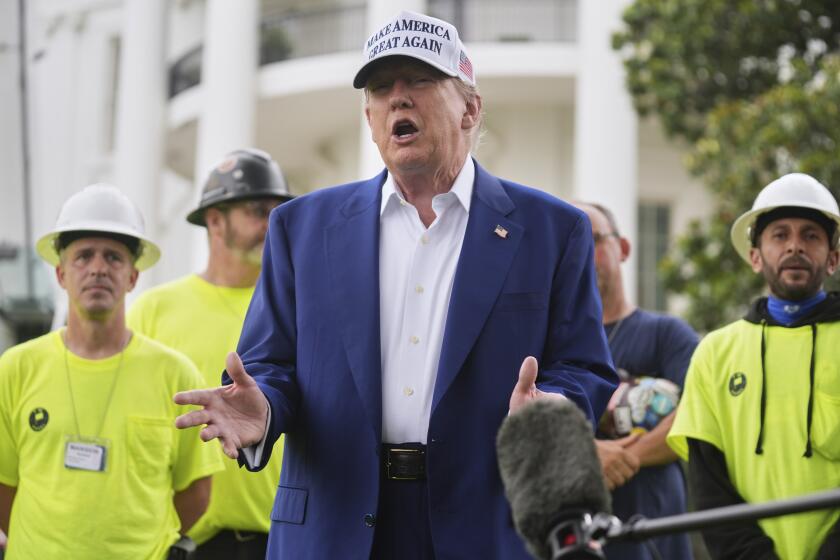King Beating Footage Comes to the Art World : Art: George Holliday’s tape represents ‘a new way of seeing what is around us,’ says the Whitney curator who chose it for the museum’s Biennial.
- Share via
George Holliday probably didn’t have art on his mind that fateful night two years ago when he was awakened by helicopters circling over his apartment in Lake View Terrace. He simply threw on his pants, grabbed his new camcorder, ran out to his patio and filmed Los Angeles police officers beating Rodney G. King. As the manager of a plumbing business and one of millions of people who have video cameras at home, Holliday impulsively used his new gadget to record a horrifying drama that unfolded before him.
“I knew the videotape was important the first time I saw it,” said John G. Hanhardt, the Whitney’s curator of film and video. Few would disagree with him, in light of the tape’s prominence in subsequent trials and the riots that followed the verdicts. But few in the art world would have predicted that Holliday’s 10-minute videotape of the infamous incident would turn up in the “1993 Biennial Exhibition” at the Whitney Museum of American Art in New York.
“It was my choice,” said Hanhardt, who selected the video and film component of what has become the nation’s most prestigious--and controversial--exhibition of recent contemporary art. In his view, the Holliday tape is not only art, it is of ground-breaking significance because it represents “a new way of seeing what is around us.”
Holliday’s amateur work reflects the phenomenon of video technology’s widespread availability, the curator said in a telephone interview. At the same time, the tape is in the forefront of a current trend among media artists to break through traditional boundaries and “engage in a public discourse,” he said. Like recognized artists whose work “redefines media arts as a public art form,” the Holliday tape “extends the definition of the documentary,” Hanhardt said.
“The videotape of the Rodney King incident . . . is paradigmatic of the new relationship media has to its community, and to television itself. And in some ways, it is a symbol of the media arts included in the ‘1993 Biennial Exhibition,’ ” the curator has written in the exhibition catalogue.
Holliday’s camerawork is in line with artists’ use of the medium, Hanhardt said. When the videotape is seen in its entirety, starting inside Holliday’s apartment and moving outside, it shows his effort to use the camera “as a means of understanding what was going on.” He made the kinds of creative decisions that artists make in doing their work, Hanhardt said.
Inclusion of the Holliday work in the “Biennial” must be considered in the context of the exhibition’s entire video component, including 10 tapes by the Gulf Crisis TY Project, a collective project that linked various communities by satellite and recorded participants views of the war, Hanhardt said. “It’s part of a whole body of work I am showing which focuses on an emerging practice within video to rethink the medium and address public issues,” he said.
The tape of the King beating also should be viewed in the larger context of art history, according to the curator. “There’s a long history of art showing us something about the world; the Holliday tape adds a new dynamic to that tradition,” he said. “George Holliday has revealed something about the world, the police brutality which we have heard about but most of us haven’t seen.”
Holliday couldn’t be reached for comment, but his attorney, Ronald W. Grigg, said his client is pleased that the Whitney is showing the entire 10-minute tape, and not just the portion that has been frequently seen on television. Holliday is also “excited about having created something unique” that has been the subject of widespread discussion and has raised important social issues in Los Angeles, Grigg said.
As to his client’s former art experience, Grigg said it was limited to developing a line of silk-screened T-shirts. Video is “a new excursion” for him, Grigg said.
Holliday had never heard of the Whitney Biennial until Hanhardt contacted Grigg and requested the tape for the exhibition, the attorney said. Grigg met with Hanhardt and museum director David Ross in New York before releasing the tape to the exhibition. Holliday may have been surprised by the museum’s request, but “I wasn’t,” Grigg said. “In spite of the fact that he wasn’t consciously making art at the moment of creation, what he did is something very significant.”
The museum made a contribution to Social Reform, Inc., a nonprofit corporation that Holliday set up after the riots and hopes to fund with proceeds from the settlement of a pending suit against KTLA and other broadcasting companies. (KTLA paid Holliday $500 for use of the tape on its evening news program. The suit contends that additional uses of the tape were unauthorized, but the defendants have denied the charges.) Grigg characterized the gift as “a gesture of appreciation” and “not a great chunk of money.” A museum press officer confirmed that a gift had been made but declined to state the amount.
Meanwhile Grigg himself has been thrust into the sphere of crime-videos-as-cutting-edge-art. He also represents Timothy Goldman who filmed the beating of truck driver Reginald O. Denny during the Los Angeles riots. Whitney curators viewed the Goldman tape but decided against using it in the “1993 Biennial Exhibition” and have no plans to include it in future programs, according to the press officer.
More to Read
The biggest entertainment stories
Get our big stories about Hollywood, film, television, music, arts, culture and more right in your inbox as soon as they publish.
You may occasionally receive promotional content from the Los Angeles Times.










